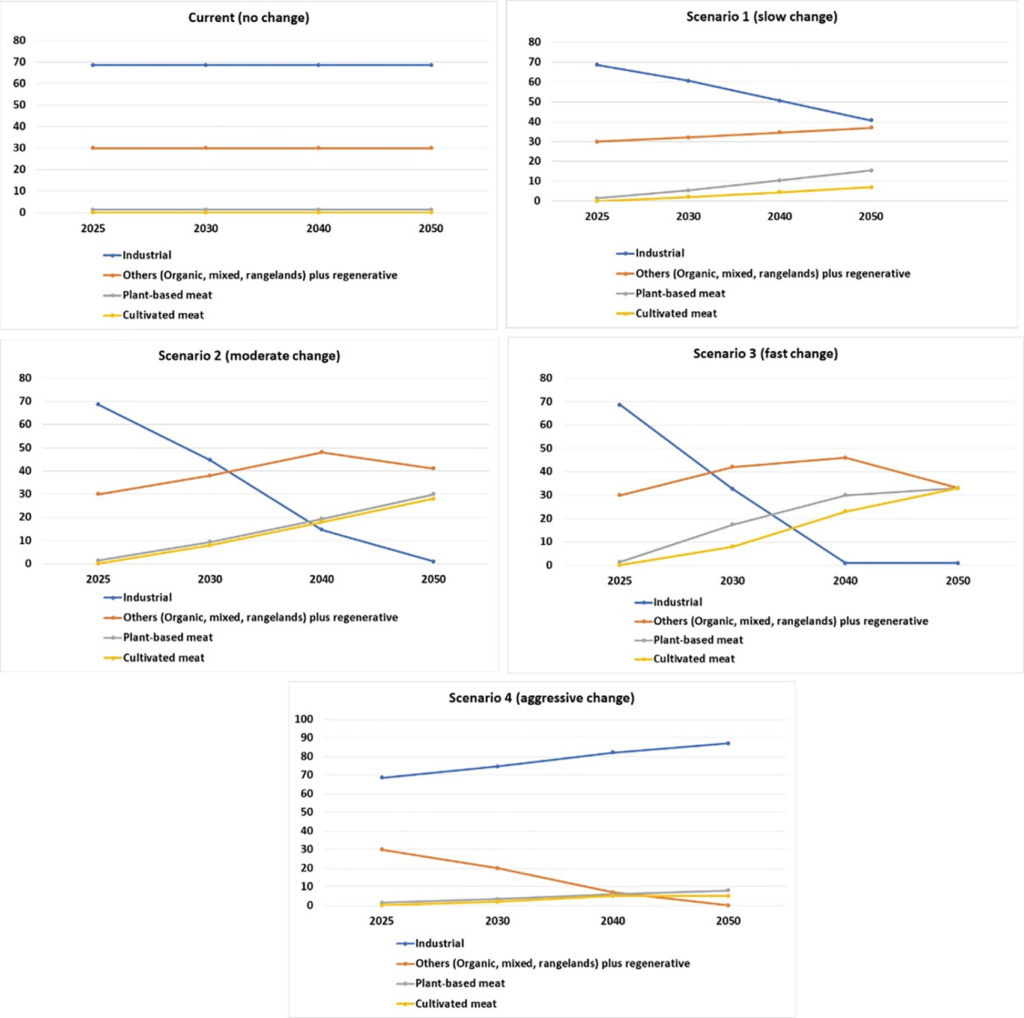
Cultivated meat, plant-based proteins and regenerative agriculture can facilitate a “just transition” of the protein industry, but factory farming needs to stop, a new study shows.
In the energy industry, a just transition means replacing coal with renewable power. But when it comes to the agrifood sector, one system can’t simply be replaced with another, according to a new study.
This is because food systems are “deeply embedded in culturally sensitive social structures and practices”, so a combination of methods is the key to ensuring a just transition of protein production. The answer may lie in a shift to regenerative agriculture and an increase in cultivated meat and plant-based proteins, alongside a rapid descaling of factory farming.
The study, published in the Plos One journal, is the result of a four-year collaboration between Federation University Australia and Israeli cultivated beef producer Aleph Farms. The researchers evaluated 13 protein systems against 25 social, environmental, economic and governance indicators – these included seven beef production methods, one industrial pork system, two poultry systems, one plant-based alternative, and two types of cultivated meat (made via both conventional and renewable energy).
The findings – built on a review of 285 studies – show that novel proteins like cultivated meat have a positive impact across several areas, and are a better way to produce proteins than most.
Cultivated meat a positive lever for the protein transition

The researchers ranked each production system based on its impact on the indicators, with each category assigned a maximum positive and negative score.
For example, concentrated animal feeding operations (CAFOs) in the US had a score of -43 in the natural capital category (two above the lowest possible score), which included impacts like greenhouse gas emissions, land use change, on-farm waste, and water pollution.
Industrial pork and caged poultry both scored -14 (the lowest possible total being -25) on human capital indicators, which refer to farmers’ and consumers’ health, workplace safety, and more.
Cultivated meat performed positively across key environmental and social measures. When produced from sustainable energy, it had a combined score of six for GHG emissions, water and air pollution, land use change, and land degradation.
It had an extremely positive impact on governance structures (a score of five) and workplace safety (four), and is beneficial for greater opportunities for youth (three), policy influence (three), and worker skills and knowledge (two). Aside from the net emissions, the impact was nearly identical across both conventional and green energy production systems for cultivated meat.
Nine systems had overall positive impacts, led by regenerative farming (a score of 63 on a scale of -125 to 125), followed by organic systems (45). Cultivated meat from sustainable energy came in fifth position (24 points), three points ahead of the same from fossil-derived energy.
Plant-based systems had an overall score of two, with lower scores on water pollution, soil contamination and other natural capital indicators due to their association with on-farm primary production. “This is because large amounts of lentils, grains, oilseed crops, etc., that form the key ingredients of highly processed plant-based food are grown using conventional farming methods,” the researchers explained.
Four protein production methods had negative impacts: CAFOs (-46), industrial pork (-45), poultry (-35) and small-scale beef (-25).
Cultivated meat would earn 33% market share in ideal just transition scenario

The authors then developed five “what if” scenarios for a just transition of protein production. The current scenario assumes business as usual, followed by situations outlining slow, moderate, fast and aggressive change.
The fast-change scenario had the highest impact score, entailing a rapid reduction of industrial animal farming to 1% of the global market by 2040 (it currently occupies a 69% share). Simultaneously, plant-based proteins and cultivated meat each make up a third of the protein market by 2050 in this case.
Regenerative agriculture emerged as the most effective approach for a just transition, with the authors highlighting its “enormous potential to contribute to climate-resilient, equitable and economically sustainable protein production systems”. “However, negative impacts associated with greenhouse gas emissions, freshwater extraction and livestock diversity need to be addressed,” they added.
With cultivated meat, meanwhile, concerns about net emissions, energy use, and water consumption “remain unaddressed”. But there’s a caveat. “If the production of cultivated meat grows significantly in the future, it may effectively reduce the overall negative impacts of the protein production systems,” the study stated.
The researchers point out how a large number of negative impacts could lead to adverse regulatory responses to certain protein systems, attracting heavy penalties, consumer backlash, and investor fallout. “Livestock farmers and protein producers can target short-, medium- and long-term responses to avoid risks arising from negative impacts,” they wrote.
It is the first of a series of reports being produced by the Federation University and Aleph Farms, and comes at a time when politicians in the US and the EU are attempting to restrain cultivated meat with bans and proposed restrictions. One of the chief drivers of the efforts is the potential impact on farmers, despite livestock producers being open to the technology and speaking out against policy restrictions on it.
The post Cultivated Meat Can Usher In A Just Transition of Protein Systems appeared first on Green Queen.
This post was originally published on Green Queen.